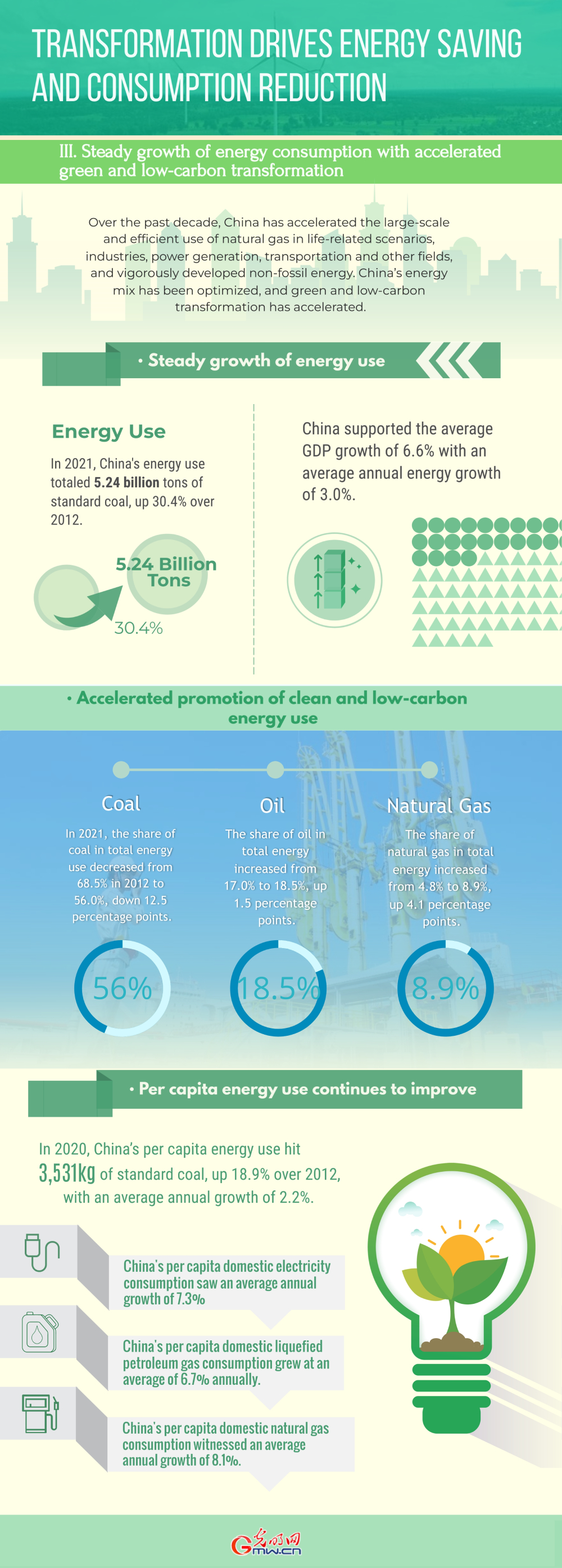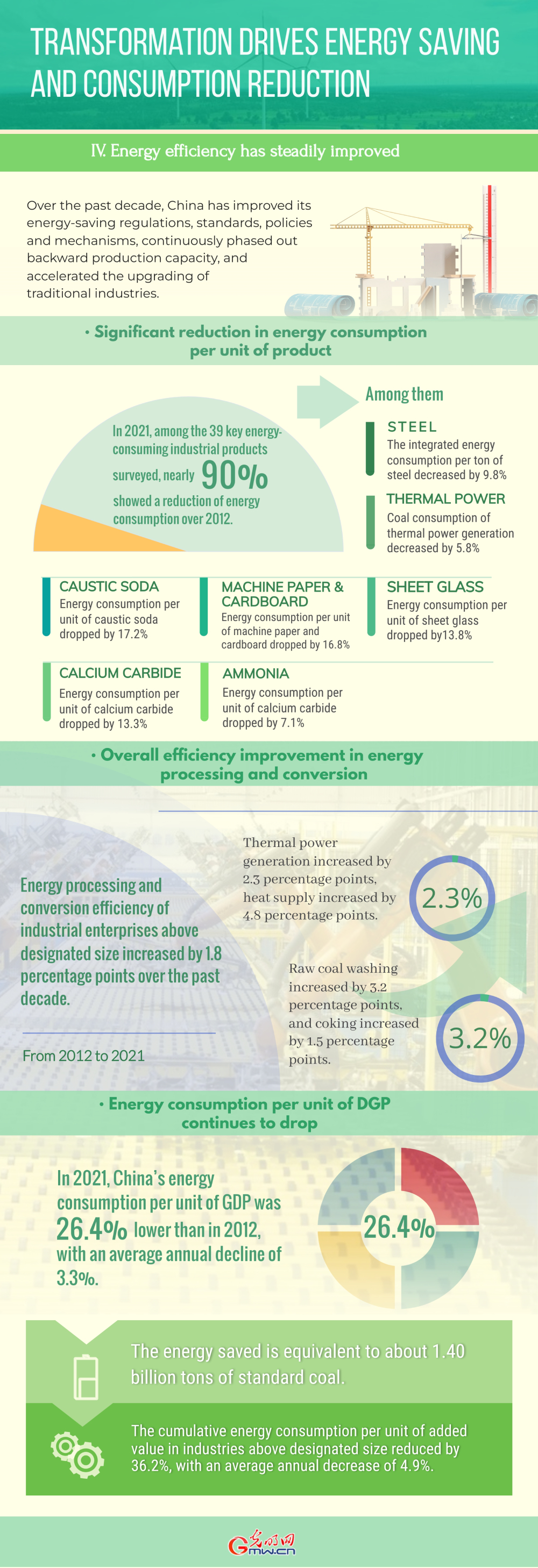Since the 18th CPC National Congress, with the advance of the structural reform on the supply side of energy, China’s energy security has been strengthened thanks to a diversified channel of energy supply and accelerated low-carbon transformation. Moreover, remarkable progress has been made in recent years in energy efficiency and energy consumption reduction. I. Improved energy security with clean energy taking a bigger proportion Since the 18th Party Congress, China has actively expanded its energy supply through structural reforms and diversifying the provision of multiple forms of energy. China has prioritized the development of renewable energy, promoted the clean and efficient utilization of coal, and increased oil and gas exploration. Supply capacity is constantly enhanced, and the process of clean energy production has accelerated. 1. Coal production structure is greatly optimized At the end of 2021, the number of coal mines nationwide was reduced to fewer than 4,500, the output of large coal mines with an annual capacity of more than 1.2 million tons accounted for about 85%, and main producers were concentrated in Shanxi, Shaanxi and Inner Mongolia. Production of raw coal has grown for five consecutive years since 2017, and coal output exceeded the historical high of 3.97 billion tons in 2013 and reached 4.13 billion tons in 2021. 2. Greater efforts in oil and gas exploration Thanks to the “Seven-Year Action Plan” on increasing oil and gas production, crude oil production has increased continuously from 2019 to 2021, reaching about 200 million tons. The output of natural gas has increased by more than 10 billion cubic meters for five consecutive years from 2017 to 2021. China’s natural gas output reached 207.6 billion cubic meters in 2021, up 87.7% from 2012, with an average annual growth of 7.2%. 3. Electricity supply continues to increase As of the end of 2021, the total installed power generation capacity had reached 2.38 billion kW, 1.1 times higher than that of 2012, with an average annual growth of 8.4%. Electricity generation capacity in 2021 hit 8.5 trillion kWh, up 71.1% over 2012, with an average annual growth of 6.1%. Among them, thermal power increased 49.1% over 2012, with an average annual growth of 4.5%; hydroelectric power increased by 53.5%, with an average annual growth of 4.9%; nuclear power increased by 3.2 times, an average annual growth of 17.2%; wind power increased by 5.8 times, an average annual growth of 23.8%; solar power increased from 25.1 billion kWh in 2014 to 325.8 billion kWh in 2021, an increase of 12.0 times, an average annual growth of 44.2%. New energy (wind, solar and other new energy) power generation increased by 6.8 times, with an average annual growth of 25.7%, accounting for 11.5% of all electricity generated, up 9.0 percentage points over 2012. 4. A changing energy mix with clean energy accounting for a bigger proportion In 2021, the installed capacity of non-fossil energy exceeded that of coal power for the first time, reaching 1.12 billion kW, accounting for 47.0% of the total installed power generation capacity. The installed capacity of hydro, wind and solar power generation exceeded 300 million kW, ranking first globally for many years. II. Diversified energy imports with deepening international cooperation Since the 18th Party Congress, China has strengthened international cooperation in the field of energy, effectively utilized international resources, and promoted energy infrastructure interconnectivity. The construction of five major oil and gas cooperation zones in Central Asia-Russia, the Middle East, Africa, the Americas, and the Asia-Pacific has made steady progress, and four strategic oil and gas import channels in the northwest, northeast, southwest and from offshore have basically taken shape. 1. Steady growth of energy imports In 2021, the country’s net energy imports totaled 1.12 billion tons of standard coal, an increase of 83.2% over 2012, with an average annual growth of 7.0%. Net imports of crude coal have steadily increased for six consecutive years since 2016. In 2021, net imports of crude coal reached 320 million tons, a record high in recent years, up 14.9% from 2012, with an average annual growth of 1.6%. Net imports of crude oil have remained high since 2019 after exceeding 500 million tons, reaching 510 million tons in 2021, up 90.0% from 2012, with an average annual growth of 7.4%. The net import of natural gas has increased at a high rate, reaching 162 billion cubic meters in 2021, 3.1 times more than in 2012, with an average annual growth of 17.1%. 2. Fruitful international energy cooperation In 2021, China’s dependence on foreign energy hit 20.6%, 5.7 percentage points higher than in 2012. With the deepening of BRI cooperation on energy, China has made new breakthroughs by building intergovernmental mechanisms with a number of countries and regions and partnering with international organizations and multilateral mechanisms in the energy sector. III. Steady growth of energy consumption with accelerated green and low-carbon transformation Since the 18th Party Congress, China has dramatically expanded energy use, accelerated the large-scale and efficient use of natural gas in life-related scenarios, industries, power generation, and transportation and other fields, and vigorously developed non-fossil energy. China’s energy mix has been optimized, and green and low-carbon transformation has accelerated. 1. Steady growth of energy use In 2021, energy use nationwide totaled 5.24 billion tons of standard coal, up 30.4% over 2012, supporting the average GDP growth of 6.6% with an average annual energy growth of 3.0%. 2.Accelerated promotion of clean and low-carbon energy use In 2021, the share of coal in total energy use decreased from 68.5% in 2012 to 56.0%, down 12.5 percentage points; the share of oil increased from 17.0% to 18.5%, up 1.5 percentage points; the share of natural gas, hydro, nuclear, and other new energy sources increased significantly, and the share of natural gas increased from 4.8% to 8.9%, up 4.1 percentage points. The proportion of primary electricity and other energy sources rose from 9.7% to 16.6%, up 6.9 percentage points. 3. Per capita energy use continues to improve In 2020, China’s per capita energy use hit 3,531 kg of standard coal, up 18.9% over 2012, with an average annual growth of 2.2%. In 2020, China’s per capita domestic energy use reached 456 kg of standard coal, up 46.2% over 2012 with an average annual growth of 4.9%; per capita domestic electricity consumption saw an average annual growth of 7.3%, per capita domestic liquefied petroleum gas consumption grew at an average of 6.7% annually, and per capita domestic natural gas consumption witnessed an average annual growth of 8.1%. IV. Energy efficiency has steadily improved Since the 18th Party Congress, China has improved its energy-saving regulations, standards, policies and mechanisms, continuously phased out backward production capacity, and accelerated the upgrading of traditional industries. New momentums have emerged in energy saving and energy consumption reduction in industries, construction, and the transportation sector. 1. Significant reduction in energy consumption per unit of product In 2021, among the 39 key energy-consuming industrial products surveyed, nearly 90% showed a reduction in energy consumption over 2012. Among them, the integrated energy consumption per ton of steel decreased by 9.8%, coal consumption of thermal power generation decreased by 5.8%, the energy consumption per unit of caustic soda, machine paper and cardboard, sheet glass, calcium carbide, and ammonia dropped by 17.2%, 16.8%, 13.8%, 13.3%, and 7.1%, respectively. 2. Overall efficiency improvement in energy processing and conversion In 2021, industrial enterprises above designated size had an energy processing and conversion efficiency up 1.8 percentage points over 2012. Among them, thermal power generation increased by 2.3 percentage points, heat supply increased by 4.8 percentage points, raw coal washing increased by 3.2 percentage points, and coking increased by 1.5 percentage points. 3. Energy consumption per unit of GDP continues to drop In 2021, China’s energy consumption per unit of GDP was 26.4% lower than in 2012, with an average annual decline of 3.3%, equivalent to saving about 1.40 billion tons of standard coal. Among them, the cumulative energy consumption per unit of added value in industries above designated size reduced by 36.2%, with an average annual decrease of 4.9%.



China in a Decade: Transformation drives energy saving, consumption reduction
Editor:谭婕倪
Source:gmw.cn
Updated:2022-10-25 16:01:32
Source:gmw.cn
Updated:2022-10-25 16:01:32
Special
Contact
Welcome to English Channel! Any suggestion, welcome.Tel:0731-82965627
lisl@rednet.cn
zhouqian@rednet.cn











